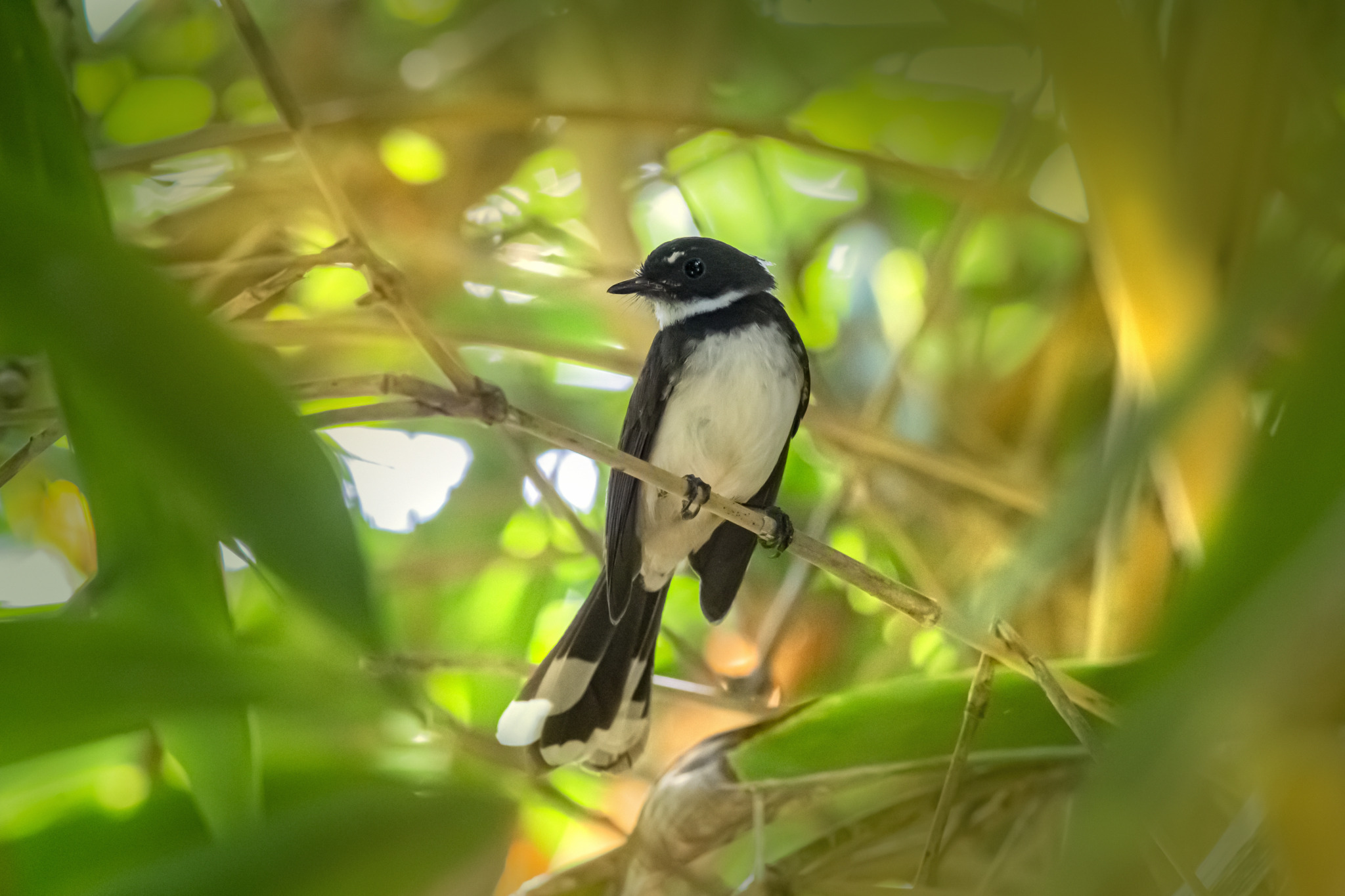Here’s a detailed overview of the Oriental Magpie-Robin (Copsychus saularis), one of Asia’s most familiar and melodious songbirds — often seen in gardens, forests, and parks across South and Southeast Asia.
🐦 Oriental Magpie-Robin (Copsychus saularis)
Taxonomy
- Kingdom: Animalia
- Phylum: Chordata
- Class: Aves
- Order: Passeriformes
- Family: Muscicapidae (Old World flycatchers)
- Genus: Copsychus
- Species: C. saularis
Common Names
- Oriental Magpie-Robin
- Indian Robin (historical usage)
- Doyel or Doel (Bangladesh, where it is the national bird)
Description
A small, elegant bird with a distinctive black-and-white plumage and a long, expressive tail. Known for its beautiful and varied song, especially during the breeding season.
- Length: 19–21 cm
- Wingspan: 25–30 cm
- Weight: 30–40 g
- Plumage:
- Male: Glossy black upperparts, white underparts, and a prominent white wing patch. Tail is long and black with white outer feathers.
- Female: Greyish-black upperparts and duller underparts (grey-white instead of pure white).
- Juvenile: Brownish-grey with speckled breast.
- Bill: Slender, black.
- Eyes: Dark brown.
- Legs and feet: Blackish-grey.
Distribution
- Widespread in South and Southeast Asia, including:
- India, Bangladesh, Nepal, Sri Lanka, Myanmar, Thailand, Laos, Cambodia, Vietnam, Malaysia, Indonesia, southern China, and the Philippines.
- Introduced populations exist in parts of the Middle East and Australia (rare escapees).
Habitat
- Found in a wide range of habitats, including:
- Open forests and woodland edges
- Parks, gardens, and plantations
- Mangroves and scrublands
- Urban and rural areas
- Common from lowlands up to 1,500 m, occasionally higher in hilly regions.
Behavior
- Active and confident; often perches upright with tail cocked upward.
- Frequently sings from exposed perches, rooftops, or tree branches.
- Territorial during the breeding season — males defend their area vigorously.
- Flight: Fast and direct with shallow wingbeats.
Diet
- Primarily insectivorous, feeding on:
- Beetles, grasshoppers, caterpillars, ants, and other small invertebrates.
- Also eats earthworms, spiders, and occasionally small lizards or berries.
- Forages mainly on the ground, hopping and flicking its tail while searching for prey.
Breeding
- Breeding season: February to July (varies with region).
- Nesting sites: Tree holes, crevices in walls, drainpipes, or nest boxes.
- Nest: Cup-shaped, made of grass, leaves, roots, and twigs, lined with hair or soft materials.
- Clutch size: 3–5 eggs.
- Eggs: Pale blue or greenish with brown speckles.
- Incubation: About 10–12 days, mainly by the female.
- Fledging: Chicks leave the nest after 2 weeks, both parents feed them.
Song and Calls
- Renowned for its rich, melodious song — often a series of clear, fluty whistles.
- The male sings vigorously at dawn and dusk, especially during the breeding season.
- Known to mimic the calls of other birds and even mechanical sounds in urban areas.
- Common calls: “chee-ree-chee”, “wee-wee”, or “twee-twee”.
Conservation Status
- IUCN Red List: 🟩 Least Concern
- Populations are stable or increasing in most areas.
- Locally protected in several countries due to past trapping for the cage-bird trade.
Cultural Significance
- National bird of Bangladesh, symbolizing beauty and melody.
- Featured in local folklore, poetry, and postage stamps.
- In Thailand and Myanmar, considered a sign of good fortune when nesting near homes.
Interesting Facts
- The male’s tail-raising display is used both in courtship and territorial defense.
- Highly adaptable — thrives in urban gardens and temple grounds.
- Despite being small, its song can be heard hundreds of meters away.
- Acts as a natural pest controller, reducing garden insect populations.
In Krabi, Thailand
In Krabi and southern Thailand, the Oriental Magpie-Robin is common year-round, especially around gardens, forest edges, and mangrove fringes.
- Often seen perched on fences or low branches, singing early in the morning.
- During the breeding season (March–June), pairs can be observed building nests in wall crevices or coconut palms.
Visited 15 times, 5 visit(s) today
Views: 246
Subscribe to the newsletter:
